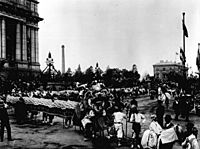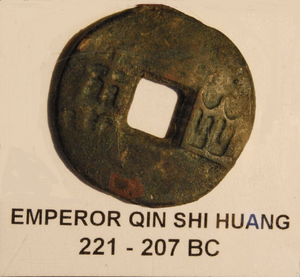Golden Dragon Museum facts for kids
| 金龙博物馆 | |
 |
|
 |
|
| Established | 1991 |
|---|---|
| Location | Dai Gum San 1-11 Bridge St, Bendigo, Victoria, Australia |
| Type | History museum |
The Golden Dragon Museum is a special place in Bendigo, Victoria, Australia. It teaches us about the culture and history of Chinese Australians, especially those who lived in the Bendigo area. The museum is built where one of Bendigo's old Chinese communities, called Chinatowns, used to be. The museum area also has beautiful Chinese Gardens and a temple dedicated to Kuan Yin. It was the first museum in Victoria to be officially recognized for its high standards.
Contents
Discovering the Golden Dragon Museum
The Golden Dragon Museum first opened its doors in 1991. It stands on the very spot where one of Bendigo's Chinatowns once thrived. This Bridge Street Chinatown was a busy center for Chinese people from the late 1800s until 1964. Sadly, the old buildings were removed to make space for a car park.
In the 1980s, a person named Russell Jack had a big idea. He wanted to create a Chinese museum in the area. Once money was found for the project, Harry Charalambous was chosen as the architect. His design mixed Chinese symbols and building styles with Australian materials. Things like corrugated iron and red brick were used. This showed the unique history of the Chinese people in Bendigo.
Chinese heritage is a very important part of Bendigo's culture. During the Victorian gold rush in the late 1800s, thousands of Chinese people came to Bendigo. Most of them were young men from the Guangdong province in China. They came hoping to find better ways to earn money for themselves and their families. When they arrived in Bendigo, the Chinese people formed their own communities. They also started raising money for charities.
In the 1870s, the local Chinese community was invited to join the yearly Easter festival. Chinese elders in the area raised money to buy amazing costumes and special items for the event. These beautiful costumes are now a main part of the museum's collection. They are very old and well-kept, made from silk and gold thread.
Why is it called the Golden Dragon Museum?
In 1988, which was the Chinese year of the Golden Dragon, people started raising money for the museum. The most important item the museum wanted to have was a special parade dragon named Loong. This dragon was a big reason for the museum's name.
What Can You See at the Museum?
The Golden Dragon Museum was created to keep, protect, and teach about the history of Chinese people in Bendigo. It received a large and important collection of Chinese parade items from the Bendigo Chinese Association. These items became the start of the museum's collection. Since then, the collection has grown a lot with many donations, both small and large.
Amazing Parade Costumes from the 1880s
The museum's collection began with these incredible costumes. This huge collection includes theater costumes made from silk, furs, and gold thread. These pieces were once used in Bendigo's Easter Parade. The Chinese people in Bendigo had a long history of parades and celebrations in their goldfield camps. These were usually for Chinese New Year or other Chinese cultural events.
Later, in the 1870s, when the Easter Parade became a yearly event in Bendigo, the Chinese joined in. The Chinese part of the parade quickly became one of the most detailed and exciting sections. In these early parades, the Chinese used items they had made in Australia or brought from China.
In 1880, the Chinese community leaders in Bendigo decided to collect money from all Chinese people in the area. This money was to buy new items for the Easter Parade. They raised £750. This money was sent to China to buy many boxes filled with richly decorated theater costumes. There were enough costumes for hundreds of people to act out a Chinese court scene. There were scholars, generals, soldiers, princesses, and an emperor. Some roles in the parade were very popular. Chinese people in the area would even bid money for the honor of wearing certain costumes. All the money raised went to local charities. Much of this collection is still at the museum today.
Meet the Dragons!
The Golden Dragon Museum is home to what are thought to be the oldest and longest imperial dragons in the world. Sun Loong, the longest imperial dragon, is over 100 meters long! He was part of the Bendigo Easter Festival every year until 2019. Then, a new dragon, Dai Gum Loong, who is 125 meters long, took his place.
Loong, the oldest imperial dragon, is very important to history. He is a special part of Australian history because he was in the parades for the federation of Australia in 1901 and its 100-year celebration in 2001. The museum also has other dragons that still perform in parades today.
The John St Alban Collection
In 2001, John St Alban, a collector from Adelaide, started giving parts of his collection to the museum. He had bought these items from Chinese dealers in the 1900s. This collection includes fancy furniture and decorations from palaces and temples of the late Qing dynasty. It's rare to see such large pieces on display outside of China. These items include screens, thrones, and chairs made of special Huanghuali wood. There are also many beautiful silver, cloisonné, and bronze incense burners. Jade carvings are set into the wooden pieces and other items. Some jade pieces stand on their own. You can also see bronze and marble statues of guardians and religious figures. Porcelain items were also given. One dish has been dated back to the Song dynasty.
The Dai Gum San Wax Works Collection
The Dai Gum San Wax Works in Bendigo closed in the late 1980s. It had many wax figures of Chinese people, including one of Sun Yat-sen. All these figures were given to the Bendigo Chinese Association. When the Golden Dragon Museum opened, they became an important part of the displays. These wax figures were made in Hong Kong by Vivian Sun. They arrived in Bendigo in 1973.
The Horrie Bridges Collection
Horrie Bridges was a local man from Bendigo who loved collecting foreign money. Over many years and several trips to China, he gathered a huge collection of Chinese money. He gave this collection to the museum in 1991. The collection has several pieces of knife money from the Zhou dynasty era. The oldest round coins are two from the Qin dynasty. From there, the collection of ancient Chinese coinage is very large and complete. Horrie Bridges also collected paper money. All the paper items are from the 1900s. There are notes from the Republic of China era (1912–1949), notes from the People's Republic, and some rare notes from Manchukuo. This collection is believed to be the largest display of Chinese money anywhere in Australia.
Learning at the Museum
The Golden Dragon Museum welcomes school groups from all over Australia. It has many displays that show how successful and valuable multiculturalism is. The museum also has displays that show the difficulties many Chinese people faced. This was due to rules that made it hard for non-European people to live in Australia in the early 1900s. Besides these specific displays, the many Chinese items are great examples of Chinese culture and history.
The Golden Dragon Museum also offers fun craft workshops for visiting groups. It shares its knowledge with other community museums around Australia too. In 2013, the museum started offering Chinese language classes in the evenings.





